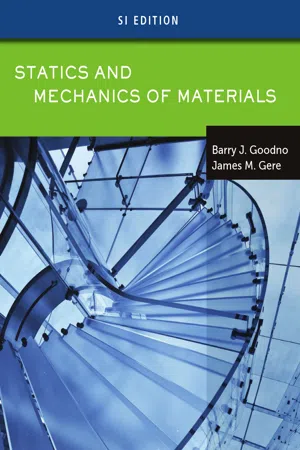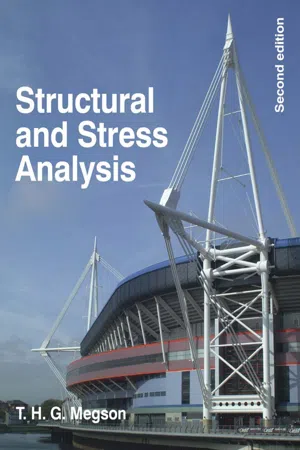Technology & Engineering
Couple Moment
A couple moment refers to the rotational effect produced by a pair of forces acting in opposite directions but not along the same line. It is a measure of the tendency of the forces to rotate an object around a specific axis. In engineering, understanding and calculating couple moments is crucial for designing and analyzing structures and mechanical systems.
Written by Perlego with AI-assistance
Related key terms
1 of 5
3 Key excerpts on "Couple Moment"
- Barry Goodno, James Gere(Authors)
- 2018(Publication Date)
- Cengage Learning EMEA(Publisher)
A practical example of a couple is shown in Fig. 2-57. Forces P are applied to a lug wrench to loosen a wheel bolt, and the couple magni- tude is M 53 N m 5 ? . The motorist can apply the couple to the wrench as P d ( )(2 ) (110 N)(482 mm) 1 1 5 or as P d ( )(2 ) (140 N)(378 mm) 2 2 5 . The two couples are said to be equivalent because any choice of force times distance (two possible choices of position of forces along one arm of the wrench are shown in Fig. 2-57) that results in a moment of 53 N ? m has the same turning effect on the wheel bolt. For some problems (especially three-dimensional problems), it is more convenient to use the vector cross product to find couple M. Consider the two-dimensional body in Fig. 2-58a (or the three- dimensional body in Fig. 2-58b) with parallel forces F , equal in mag- nitude and opposite in sense, applied along lines of action through points A and B. The moment about some point O is M r F r F r F r r F M r F or OA OB OA OA BA BA 5 1 2 5 1 2 2 5 ( ) ( ) ( ) × × × × × (2-128) The moment M depends only on the relative position of the two forces and not on the location of point O about which moments are taken. The couple is the same about all points on the body, so moment vector M is a free vector whose sign is established using the right-hand rule. The magnitude of moment M is M Fd 5 where d is again the perpendicular distance between the lines of action of forces F (Fig. 2-58b). Couples can be combined using the rules for addition and subtraction of vectors. Force-Couple System When considering the effect of force F acting on a body, you are often interested in the effect of that force at some other point on the body. You can use the concept of a couple to replace the original force acting at some point A (Fig. 2-59a) with an equivalent force and moment at another point of interest B (Fig. 2-59b). In transferring force F from point A to point B, you must also transfer the turning effect of the force ( ) B M .- eBook - PDF
- T.H.G. Megson(Author)
- 2005(Publication Date)
- Butterworth-Heinemann(Publisher)
In Fig. 2.14(b) the moment, M , is applied in the plane of the cross section of the beam and will therefore produce twisting; in this case M is called a torque . F IGURE 2.13 Resolution of a moment y M yz M yz M sin u M xz M cos u M xz M (a) (b) z x u M u 30 • Chapter 2 / Principles of Statics F IGURE 2.14 Action of a moment in different planes M (a) M (b) F IGURE 2.15 Moment of a couple O A B F F COUPLES Consider the two coplanar, equal and parallel forces F which act in opposite directions as shown in Fig. 2.15. The sum of their moments, M O , about any point O in their plane is M O = F × BO − F × AO where OAB is perpendicular to both forces. Then M O = F (BO − AO) = F × AB and we see that the sum of the moments of the two forces F about any point in their plane is equal to the product of one of the forces and the perpendicular distance between their lines of action; this system is termed a couple and the distance AB is the arm or lever arm of the couple. Since a couple is, in effect, a pure moment (not to be confused with the moment of a force about a specific point which varies with the position of the point) it may be resolved into components in the same way as the moment M in Fig. 2.13. EQUIVALENT FORCE SYSTEMS In structural analysis it is often convenient to replace a force system acting at one point by an equivalent force system acting at another. For example, in Fig. 2.16(a), the effect on the cylinder of the force F acting at A on the arm AB may be determined as follows. If we apply equal and opposite forces F at B as shown in Fig. 2.16(b), the overall effect on the cylinder is unchanged. However, the force F at A and the equal and opposite 2.3 The Resultant of a System of Parallel Forces • 31 F IGURE 2.16 Equivalent force system Cylinder Arm A A (a) (b) (c) a a F F F F Fa F B B B force F at B form a couple which, as we have seen, has the same moment ( Fa ) about any point in its plane. - eBook - PDF
Statics and Mechanics of Materials
An Integrated Approach
- William F. Riley, Leroy D. Sturges, Don H. Morris(Authors)
- 2017(Publication Date)
- Wiley(Publisher)
5-5 COUPLES Two equal, noncollinear, parallel forces of opposite sense (see Fig. 5-19) are called a couple. Since the two forces are equal, parallel, and of opposite sense, the sum of the forces in any direction is zero. Therefore, a couple tends only to rotate the body on which it acts. The moment of a couple is defined as the sum of the moments of the pair of forces that comprise the couple. For the two forces F 1 and F 2 shown in Fig. 5-19, the moments of the forces about points A and B in the plane of the couple are M A |F 2 | d M B |F 1 |d However, |F 1 | |F 2 | F therefore, M A M B Fd which indicates that the magnitude of the moment of a couple about a point in the plane of the couple is equal to the magnitude of one of the forces multiplied by the perpendicular distance between the forces. The point A or B does not have to lie on one of the forces but must lie in the plane of the forces. Other characteristics of a couple can be determined by considering two par- allel forces in space such as those shown in Fig. 5-19. The sum of the moments of the two forces about any point O is M O r 1 F 1 r 2 F 2 or, since F 2 equals F 1 , M O r 1 F 1 r 2 (F 1 ) (r 1 r 2 ) F 1 r AB F 1 where r AB is the position vector from any point B on the line of action of force F 2 to any point A on the line of action of force F 1 . Therefore, from the defini- tion of the vector cross product, M O r AB F 1 |r AB | |F 1 | sin e F 1 d e (5-21) 182 CHAPTER FIVE / EQUIVALENT FORCE/MOMENT SYSTEMS Figure P5-41 y z x O 12 in. 10 in. 10 in. 15 in. D E A B F C 5-41 The magnitude of the force F in Fig. P5-41 is 781 lb. De- termine (a) The component of the moment at point C parallel to line CD. (b) The component of the moment at point C perpendicu- lar to line CD and the direction angles associated with this moment vector. y z x d A B r 1 r 2 r A/B F 2 F 1 α Plane containing the two forces and r A/B O Figure 5-19
Index pages curate the most relevant extracts from our library of academic textbooks. They’ve been created using an in-house natural language model (NLM), each adding context and meaning to key research topics.


